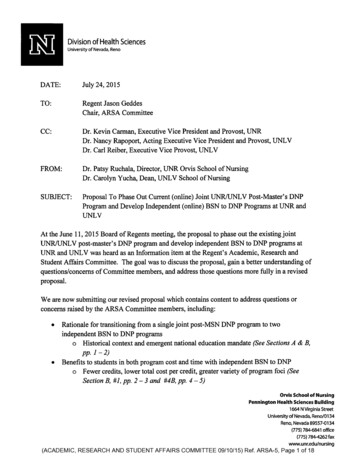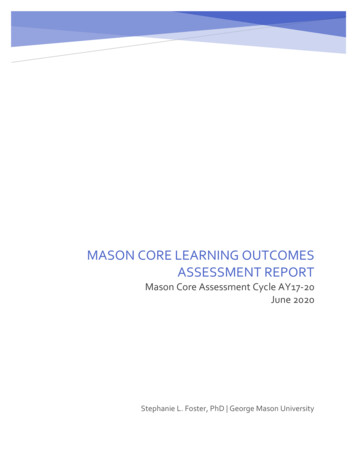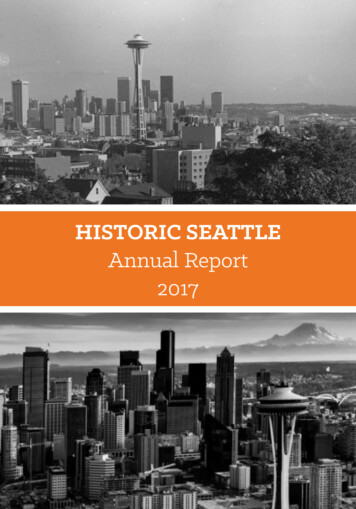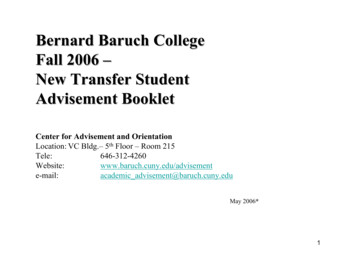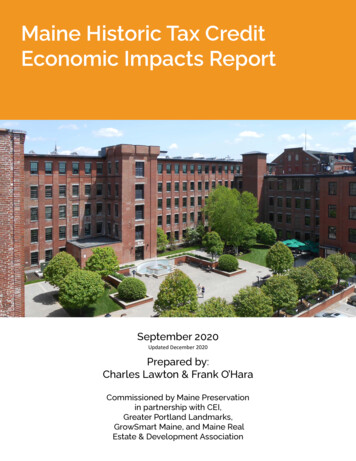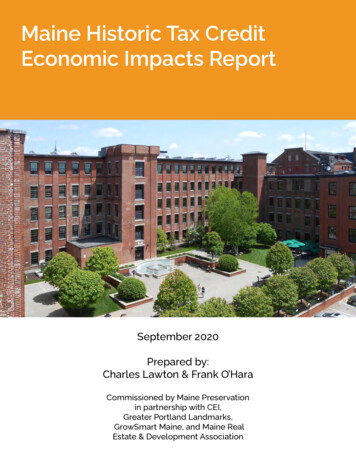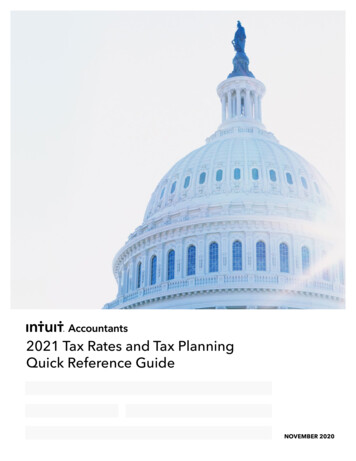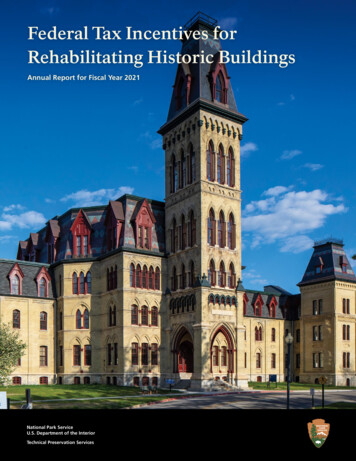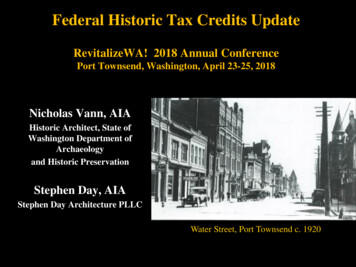
Transcription
Federal Historic Tax Credits UpdateRevitalizeWA! 2018 Annual ConferencePort Townsend, Washington, April 23-25, 2018Nicholas Vann, AIAHistoric Architect, State ofWashington Department ofArchaeologyand Historic PreservationStephen Day, AIAStephen Day Architecture PLLCWater Street, Port Townsend c. 1920
Making the Most of Historic Tax Credits:Tax Credit Essentials – Powerful Tools inPreserving and Revitalizing Historic ArchitectureStephen Day, AIA1326 Fifth Avenue, Suite 654Seattle, WA 98101(206) 625-1511stephen@stephendayarchitecture.comArctic Club Hotel, Seattle
Stephen Day Architecture PLLC focuses on:- Preservation architecture- Historic properties re-development andpartnership structuring- Design analysis and research servinghistoric properties redevelopment-National Register nominations-National Park Service Parts 1, 2, 3Stephen Day, AIA(206) lawgroup.com.comColman Automotive Building, Seattle
Tax Credit Segment:I.Background on the CreditsII.Basic Rules for the Credits –Updated in 2018III. Using the Credits –For-Profit andNon-Profit UsersIV. Tax Credit Project ChecklistHastings Building, Port Townsend, WA
I. BACKGROUNDTax Credits and tax creditlaws can be great tools to usein architectural preservationCan produce needed cashequity early in these projectsCredits can turn marginalprojects into feasible projectsAnhalt Apartment Building, SeattleNational Trust ConferencePlanning Successful Tax Credit Rehabilitations
I. BACKGROUND – Legal Foundation for the CreditsHistoric Preservation isa “legitimategovernmental role”(Penn Central v. NewYork City), upholdingincentive programs inexchange for limits ondemolition andalteration oflandmarks Grand Central Station, New York
PROJECT: ARCTIC CLUB Arctic Club Hotel,Seattle Approximately 29million in qualifiedrehab expenses Approximately 5.8million in tax creditsto investorsArctic Club Hotel Seattle
PROJECT: SPOKANE & INLAND EMPIRE RAILROAD Former railroadfabricationfacilities, convertedto office and caféuses Approximately 14million in qualifiedrehab expenses Approximately 2.8 million in taxcredits to investorsSpokane & Inland Empire RR, Spokane,1911
PROJECT: HOLLEY MASON BUILDING Industrial lofts, longunused – converted tooffice lofts Approximately 6.0million in qualifiedrehab expenses 1,200,000 in taxcredits to investors insingle entity structureHolley Mason Building, Spokane
PROJECT:THE INN AT LYNDEN Main Street departmentstore (closed fordecades) – converted toboutique hotel andretail Approximately 6.6million in qualifiedrehab expenses 1,300,000 in taxcredits to investors insingle entity structureWaples Department Store, Lynden, WA(The Inn at Lynden)
PROJECT:ANHALT APARTMENTS Classic Anhaltapartment complex onCapitol Hill, Seattle Approximately 11million in qualifiedrehab expenses 2.2 million in taxcredits to investors insingle entity structureAnhalt Apartment Building, Seattle, WA
PROJECT: THE MONTVALE HOTEL Historic hoteldevelopment Approximately 1.5million in qualifiedrehab expenses 300,000 in tax creditsto investors in singleentity structureMontvale Hotel, Spokane
PROJECT: THE “FIVE & DIME” FW WOOLWORTHBUILDING converted torestaurant and small hotel Approximately 1.3million in qualified rehabexpenses 260,000 in tax credits toinvestors in single entitystructureThe Five & Dime, Clarksdale, Mississippi
II.THE HISTORIC TAX CREDIT PROGRAM: BASICSA. WHAT IS THE PROGRAM? A 20% credit for the rehab of“certified historic structures” No longer available:10% credit for the rehab of “nonhistoric” (non-certified) and nonresidential structures built before1936Harold Poll Building, Seattle
FEDERAL INVESTMENT TAX CREDITS20% Federal Tax Credit on QualifiedRehabilitation ExpendituresExample: For 1,000,000 in rehabexpenditures a 200,000 credit can be taken.
FEDERAL INVESTMENT TAX CREDITWHO DOES WHAT?STATE HISTORIC PRESERVATION OFFICE Technical assistance (consultation) Initial contact with property owners Reviews Tax Credit ApplicationsNATIONAL PARK SERVICE Technical assistance (publications) Administers Tax Credit program CERTIFIES National Register listings andRehabilitations for Tax Credit program
BECOMING A CERTIFIED PROJECTComplete a 3-part applicationPart 1 – Evaluation of SignificancePart 2 – Description of RehabilitationPart 3 – Request for Certificationof Completed Work
FEDERAL INVESTMENT TAX CREDITNATIONWIDESince 1976 when the program began:43,328 projects nationwide 90 Billion Total Rehab Expend. 1,100 projects / year 5-6 billion / year
FEDERAL INVESTMENT TAX CREDITSTATS IN WASHINGTON STATESince 1978 when the program began:289 projects statewide 1.13 Billion Total Rehab Expend.129 Seattle projects for 779 million Total QRE 6.04 million / project60 Spokane projects for 159 million Total QRE 2.65 million / project
FEDERAL INVESTMENT TAX CREDITSOCIOECONOMIC IMPACTS Jobs created (2.4 million 1976-2012; 60,000 in 2012) Increased property values – reuse vs. blight Cumulative Economic Impact 245.2 billion in output GDP 121.2 billion – Government, Services, Finance/Ins./Real Estate, Retail, Wholesale,Transp/Utilities, Manufacturing, Construction, Mining, Agriculture Personal income 89.1 billion Cost of program vs. net gain in Federal tax receipts ( 20.5 billion in tax credits vs. NET GAIN 25.9 billion in Federal tax receipts) Environmental impact – “the greenest building” Social impact – maintaining community character / sense of place
FEDERAL INVESTMENT TAX CREDITPROJECTS AT A DISADVANTAGE Smaller Projects In Communities with little or no knowledge of program In areas where technical expertise in preservation andcraftsmanship is limited Those that do not meet Qualified Expenditure RequirementsAddressing Program ShortfallsOutreach: CLGs reaching out to property owners and developers Encourages development in smaller communities Education: Planned workshops with focus on Eastern and Central Washington Learn from other states
FEDERAL INVESTMENT TAX CREDITFOUR BASIC REQUIREMENTS1The property must be individually listed on theNATIONAL REGISTER of Historic Places or becertified as a contributing property in a NationalRegister listed Historic District
FEDERAL INVESTMENT TAX CREDITFOUR BASIC REQUIREMENTS2The proposed rehabilitation must meet the Secretaryof the Interior’s STANDARDS for the Treatment ofHistoric Properties.
SECRETARY OF THE INTERIOR’S STANDARDS3 BASIC PRINCIPLES1. Repair or replace in-kind2. Retain historic character3. Compatible, reversible interventions
FEDERAL INVESTMENT TAX CREDITFOUR BASIC REQUIREMENTS3The project must be SUBSTANTIAL – meaning theamount spent on the rehab must be at least 5,000and meet or exceed the IRS definition of the adjustedbasis of the building.Normally this means the value of the buildingitself, minus any depreciation and land value.
FEDERAL INVESTMENT TAX CREDITFOUR BASIC REQUIREMENTS4The property must be INCOME PRODUCING,including commercial, office, retail, and rentalresidential.
FEDERAL INVESTMENT TAX CREDITWHO QUALIFIES?The applicant must be an active participant in thedevelopment of the project, usually the owner, but often agroup of investors forming a limited partnership orcorporation.Cannot be a non-profit or government entity unless aprivate entity is established (limited partnership, LLC, etc.)
II.BASICSHOW LARGE OF A TAX CREDIT IS AVAILABLE? Federal Historic taxcredit 20% of the“qualified rehabilitationexpenses” (QRE’s) Example: 5 million inQRE’s providespossibility of 1 millionin tax creditsColman Automotive Building, Seattle
II.BASICSHOW DO THESE PEOJECTS GENERATE CASH? Rehab tax creditsused by owners orlong term lessees ofcertified historicstructures Can be used byindividuals in limitedcircumstances Taxable corporationsare typical creditusersWellman Building, Jamestown, NY
II.BASICSWHAT CHANGED WITH THE PROGRAM IN 2017? 10% Rehab Crediteliminated 20% Credit must bespread out over 5years (previouslycould be claimed over20 years, or all at onetime – this affectsvalue of the credit)B.P.O.E (Elks Club) Building, Bellingham, WA(this project will be subject to the new rules)
II.BASICSWHAT CHANGED WITH THE PROGRAM IN 2017? Existing projects canuse the old rules only if: (a) in ownership ofbuilding by 1/1/18 andcontinuous through therehab; and(b) rehab starts by mid2018 and concludesQRE work by mid-2020(except for phasedprojects, which can bespread over 60 months) Apartment Hotel Cissna, Bellingham, WA(this project will qualify under the old rules)
TYPICAL DEAL STRUCTURE #1OWNER, LLCMember #1Developer/ManagingMember LLCReceivesDevelopmentFeesReceives1% of theTax CreditsRemains inProjectMember #2PropertyOwnerTax CreditInvestor,LLC CashLeases withTenantsContributionIn ExchangeforTax CreditsOwns 99%Receives99% of theTax CreditsExits ProjectAfter 5 Years“Direct” Structure
TYPICAL DEAL STRUCTURE #2Manager, LLCOWNER, velopmentFeesTaxCreditPassThroughMaster TenantManager, LLC1%OwnerMasterTenantLLCTenantUnder a 39 Year MasterLeaseMaster TenantMember #2 RentOtherMembers inOwnerLLCSubleases withSubtenants CashForTaxCreditsMaster Lease StructureTax CreditInvestor,LLCMasterTenantMember #199%Owner
“QUALIFIED REHAB EXPENDITURES” (QRE’S):QRE’s can include certain hardand soft costs of rehab project,including construction costs,consultant fees, developer fees,interest during constructionHistoric tax credits QRE x 20%Pine Street Market, Portland OR
“QUALIFIED EXPENDITURES”DO NOT INCLUDE:Acquisition costs, additions tohistoric structures or newbuildings, parking structures,parking lots, landscaping/sitedevelopment costsArctic Club Hotel Penthouse, Seattle
BASICSQUALIFYING BUILDING USES: Not all building uses qualify Uses must be income producingor used in a business Rental housing yes (for 20%credit only), but condo housingalmost neverHale Building, Spokane
BASICSALLOCATING OR TRANSFERRING CREDIT: Tax credits are not freelytransferred Cannot be allocated without theunderlying ownership interest orunder a qualifying lease User must be an owner or mastertenant – credits not “sold” tooutside partiesUnited Carriage Building, Portland OR
BASICSHOW LONG MUST TAX CREDIT USER BE INPROJECT? Tax credit user must be owner orlessee for at least the minimum 5year holding period Must be owner or lessee before therehab is placed in service – cannotcome in laterHolley Mason Building, Spokane
BASICS TAX CREDIT RECAPTURECan take place if tax credit usersells interest (or master lease isterminated) before end of 5 yearholding periodHastings Building, Port Townsend, WA, 1890
III. OPPORTUNITIES IN USING THE CREDITSTHE TAX CREDIT USER Typically taxablecorporations Often local lenders onsmaller projects Can be individuals, ifthey are “real estateprofessionals” morelaterLynden Department Store, Lynden, WA
THE TAX CREDIT USER T.C. Investormust have anownershipinterest inproject or bea mastertenant undera permittedlong-termleaseHistoric YMCA, Walla Walla, WA
THE TAX CREDIT USER Tax credit investor typ.Pays anywhere between65-85 cents per 1 dollarof tax credit Tax credit “price” variesdepending upon size,location, complexity andnature of the projectNorthern State Hospital Farm, Sedro Wooley, WA
THE TAX CREDIT USER The tax credits must beallocated within thepartnership in the sameproportion as profits/lossesare allocated If 99% of the credits areallocated to an investor, somust 99% of theprofits/lossesThe Stevens Building, Clarksdale, Mississippi
THE TAX CREDIT USER The minority owner istypically the developerand project manager –and the owner withday-to-day control The minority owner ispaid fees that absorbthe great majority of netcash flow1600 East John Street, Seattle
THE TAX CREDIT USER After 5 year min.holding period, TCinvestor’s interest isreduced to as low as5%, often followedby a buy-outNorthern State Assembly Hall, Sedro Wooley, WA
THE TAX CREDIT USER:SIGNIFICANT RECENT COURT DECISIONAugust 2012 Case (3rd Circuit):“Historic Boardwalk Hall” CaseThe Tax Credit Investor MUSThave some level of financial riskand reward in the project –Must be a “partner” in more thanjust nameHistoric Boardwalk Hall, Atlantic City
THE TAX CREDIT USERCHANGES IN THE TAXCODE WITH THE“STIMULUS ACT” Net effect is that moreindividuals can use thetax credits to reducetheir personal incometax Increases the pool ofpotential tax creditinvestorsUnited Carriage Building, Portland OR
THE TAX CREDIT USER A “REAL ESTATEPROFESSIONAL” CAN BE A: DeveloperBrokerContractorProperty Manager under certain circumstances(happy to discuss) .if you are aqualified real estate professional,you may qualify to personally usethe tax credits. Otherwise youneed to partner with a qualifiedinvestor.Holley Mason Building, Spokane
OPPORTUNITIES IN USING THE CREDITS:TAX EXEMPT ENTITIES ASOWNERS/DEVELOPERS TAX EXEMPT ENTITIESCANNOT USE THECREDITS DIRECTLY So tax exempt entitymust either co-ownthe property withtaxable entity or longterm lease theproperty to a taxableentityNorthern State Hospital, Sedro Wooley, WA
TAX EXEMPT ENTITIES AS OWNERS/DEVELOPERS Tax exempt partnerwill typically ownonly a small portion ofthe entity – The tax credits mustbe allocated accordingto percentage ofprofit/loss interestsNorthern State Hospital, Sedro Wooley, WA
TAX EXEMPT ENTITIES AND “DISQUALIFIED LEASES” “Disqualified leases”include leases to taxexempt entities that are: Longer than 20 years Contain extension optionswith predetermined priceNorthern State Hospital, Sedro Wooley, WA
TAX EXEMPT ENTITIES AND “DISQUALIFIED LEASES” A project can stillfully utilize the taxcredits even if up to50% of the space isleased under“disqualifiedleases”Northern State Hospital, Sedro Wooley, WA
V. HISTORIC TAX CREDIT CHECKLIST1. Is the building on the National Register or a contributing buildingin an NR listed historic district?2. If not, does the building have the potential to be listedon National Register?3. Are rehab costs in excess of adjusted basis (basically value ofbuilding improvements made since purchase, less land value)4. Is the new plan compatible with re-use ofsignificant historic elements?
V. BASIC HISTORIC TAX CREDIT CHECKLIST5. Does the new plan require alterations (or users) that couldjeopardize approvals?6. Does the project schedule allow time for SHPO/NPS reviewand approvals?7. Will tax credit investors be invested in the project by thetime the renovated building is placed in service?8. Experienced professionals on the team?
V. HISTORIC TAX CREDIT CHECKLIST9. Is the lender involved early on in the project?10. State tax credits available?11. Property tax abatement available?
VI. THE HASTINGS BUILDING / HASTINGS LANDING 1890 Port TownsendVictorian landmark, inthe Hastings familyownership since itsoriginal development byLucinda HastingsHastings Building, Port Townsend, WA
VI. THE HASTINGS BUILDING / HASTINGS LANDING The Hastings Building was designed by Elmer H. Fisher, thearchitect who designed the Pioneer Building and many otherSeattle structures built soon after the Great Fire of 1889Water Street, Hastings Building, c. 1920Taylor Street, Hastings Building, c. 1910
VI. THE HASTINGS BUILDING / HASTINGS LANDING Our firm is designing a complete rehabilitation of the HastingsBuilding, along with a major addition, converting the building to aboutique hotel, restaurant, and event spaces.Interior Views, The Hastings Building, prior to rehabilitation
VI. THE HASTINGS BUILDING / HASTINGS LANDINGHistoric Tax Credit Issues/Secretary of the Interior Standards: Must retain the historicatrium, circulation, historic character-defining elements (interior and exterior elements)
VI. THE HASTINGS BUILDING / HASTINGS LANDINGHistoric Tax Credit Issues/Secretary of the Interior Standards: New addition must bedistinguished from the historic building, but be compatible in materials, forms, etc.
VI. THE HASTINGS BUILDING / HASTINGS LANDINGHistoric Tax Credit Issues/Secretary of the Interior Standards: Must retain and restorewhere appropriate the historic character-defining elements (interior and exterior elements)
You Can Make Great Tax Credit Projects Happen.Questions?Nicholas Vann, AIADAHP(360) 586-3079nicholas.vann@dahp.wa.govStephen J. Day, AIAStephen Day Architecture PLLC(206) 625-1511stephen@stephendayarchitecture.comArctic Club Hotel, Seattle
Seattle, WA 98101 (206) 625-1511 stephen@ stephendayarchitecture.com . partnership structuring - Design analysis and research serving historic properties redevelopment - National Register nominations - National Park Service Parts 1, 2, 3 Stephen Day, AIA . of the Interior's STANDARDS for the Treatment of Historic Properties. 2

